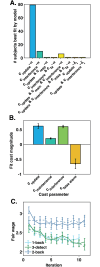Wagers for work: Decomposing the costs of cognitive effort
- PMID: 38683857
- PMCID: PMC11081491
- DOI: 10.1371/journal.pcbi.1012060
Wagers for work: Decomposing the costs of cognitive effort
Abstract
Some aspects of cognition are more taxing than others. Accordingly, many people will avoid cognitively demanding tasks in favor of simpler alternatives. Which components of these tasks are costly, and how much, remains unknown. Here, we use a novel task design in which subjects request wages for completing cognitive tasks and a computational modeling procedure that decomposes their wages into the costs driving them. Using working memory as a test case, our approach revealed that gating new information into memory and protecting against interference are costly. Critically, other factors, like memory load, appeared less costly. Other key factors which may drive effort costs, such as error avoidance, had minimal influence on wage requests. Our approach is sensitive to individual differences, and could be used in psychiatric populations to understand the true underlying nature of apparent cognitive deficits.
Copyright: © 2024 Master et al. This is an open access article distributed under the terms of the Creative Commons Attribution License, which permits unrestricted use, distribution, and reproduction in any medium, provided the original author and source are credited.
Conflict of interest statement
The authors have declared that no competing interests exist.
Figures




Similar articles
-
Aging and effort expenditure: The impact of subjective perceptions of task demands.Psychol Aging. 2016 Nov;31(7):653-660. doi: 10.1037/pag0000127. Psychol Aging. 2016. PMID: 27831709 Free PMC article.
-
Investigating the influence of working memory capacity when driving behavior is combined with cognitive load: An LCT study of young novice drivers.Accid Anal Prev. 2014 Jan;62:377-87. doi: 10.1016/j.aap.2013.06.032. Epub 2013 Jul 4. Accid Anal Prev. 2014. PMID: 23915472
-
Cognitive costs of decision-making strategies: A resource demand decomposition analysis with a cognitive architecture.Cognition. 2018 Jan;170:102-122. doi: 10.1016/j.cognition.2017.09.003. Epub 2017 Oct 5. Cognition. 2018. PMID: 28987923
-
Complex working memory span tasks and higher-order cognition: a latent-variable analysis of the relationship between processing and storage.Memory. 2009 Aug;17(6):635-54. doi: 10.1080/09658210902998047. Epub 2009 Jun 17. Memory. 2009. PMID: 19536691 Review.
-
A computational approach to prefrontal cortex, cognitive control and schizophrenia: recent developments and current challenges.Philos Trans R Soc Lond B Biol Sci. 1996 Oct 29;351(1346):1515-27. doi: 10.1098/rstb.1996.0138. Philos Trans R Soc Lond B Biol Sci. 1996. PMID: 8941963 Review.
Cited by
-
Sensorimnemonic decisions: choosing memories versus sensory information.Trends Cogn Sci. 2025 Apr;29(4):311-313. doi: 10.1016/j.tics.2024.12.010. Epub 2025 Jan 23. Trends Cogn Sci. 2025. PMID: 39855974 Free PMC article. Review.
-
Shielding working memory from distraction is more effortful than flexible updating.Sci Rep. 2025 Apr 19;15(1):13512. doi: 10.1038/s41598-025-96980-x. Sci Rep. 2025. PMID: 40251226 Free PMC article.
-
Trying harder: how cognitive effort sculpts neural representations during working memory.bioRxiv [Preprint]. 2023 Dec 8:2023.12.07.570686. doi: 10.1101/2023.12.07.570686. bioRxiv. 2023. Update in: J Neurosci. 2024 Jul 10;44(28):e0060242024. doi: 10.1523/JNEUROSCI.0060-24.2024. PMID: 38106094 Free PMC article. Updated. Preprint.
-
Trying Harder: How Cognitive Effort Sculpts Neural Representations during Working Memory.J Neurosci. 2024 Jul 10;44(28):e0060242024. doi: 10.1523/JNEUROSCI.0060-24.2024. J Neurosci. 2024. PMID: 38769009 Free PMC article.
-
Association Between Socioeconomic Status and Neuropsychiatric Symptoms in the UK Biobank: The Moderating Role of Sociability.Depress Anxiety. 2025 May 15;2025:1293449. doi: 10.1155/da/1293449. eCollection 2025. Depress Anxiety. 2025. PMID: 40406186 Free PMC article.
References
-
- Cacioppo JT, Petty RE. The need for cognition. J Pers Soc Psychol. 1982;42(1):116.
Publication types
MeSH terms
LinkOut - more resources
Full Text Sources

